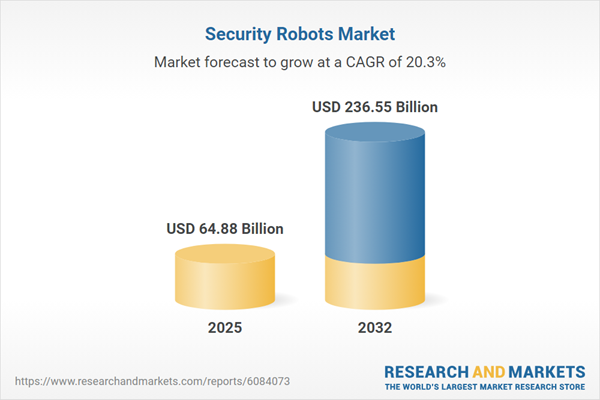Speak directly to the analyst to clarify any post sales queries you may have.
Security robots are reshaping organizational protection strategies by automating risk management, reducing human exposure, and elevating operational efficiency across high-stakes sectors. As the technology matures, it enables more effective and adaptive responses to emerging threats, supporting decision-makers in securing complex environments.
Market Snapshot: Security Robots Market Size and Growth Outlook
The security robots market expanded from USD 54 billion in 2024 to USD 64.88 billion in 2025 and is forecasted to reach USD 236.55 billion by 2032, propelled by a CAGR of 20.27%. This surge is fueled by urgent demands for autonomous risk interventions, persistent workforce shortages in dangerous roles, and organizational mandates around cost control. Security robots are moving beyond initial pilots to mainstream use in defense, infrastructure, and commercial facilities. Their adoption marks a pivotal transition, enabling organizations globally to deploy intelligent, automated security at scale for dynamic threat environments and operational challenges.
Scope & Segmentation of the Security Robots Market
This research delivers an actionable segmentation, equipping stakeholders to define precise growth opportunities, evaluate technology deployments, and navigate global dynamics within the security robots industry.
- Operation Mode: Includes fully autonomous, semi-autonomous, and tele-operated robotic platforms to suit diverse mission profiles.
- Mobility Platforms: Covers aerial robots (fixed-wing, hexacopter, quadcopter), ground vehicles (legged, tracked, wheeled using differential drive or skid steer), and underwater solutions (AUV, ROV).
- Application Areas: Addresses consumer security, defense and military operations (such as combat and reconnaissance), infrastructure inspection, logistics (including last-mile and warehouse automation), and surveillance (covering intrusion and perimeter monitoring).
- End Users: Encompasses commercial sites, industrial facilities, military and defense forces, and residential settings with tailored security needs.
- Component Categories: Explores hardware (e.g., actuators, chassis, sensors), software (AI analytics, navigation systems), and related services (integration, maintenance, training).
- Payload Classifications: Differentiate solutions by heavy, medium, and light payload capacities, supporting various operational missions.
- Regional Markets: Spans Americas (United States, Canada, Mexico, Latin America), Europe, Middle East & Africa (key countries across these regions), and Asia-Pacific (including China, India, Japan, Australia, and emerging technology hubs).
- Company Profiles: Features notable providers such as Knightscope, SMP Robotics, Gaussian Robotics, Robotic Assistance Devices, Cobalt Robotics, Ghost Robotics, ANYbotics, Adlatus Robotics, RoboteX, and MetraLabs.
Key Takeaways for Senior Decision Makers
- Security robot solutions now provide significant autonomy and adaptive navigation, decreasing reliance on human intervention in high-risk environments while optimizing precision and resource allocation.
- Advances in sensor integration and machine learning enable organizations to enhance their existing security frameworks for better predictive incident detection and streamlined response.
- Ongoing evolution of the regulatory climate is increasing confidence among stakeholders, as standards for safety, compliance, and deployment scalability mature across global markets.
- Organizations with acute security challenges and routine understaffing—such as those in critical infrastructure, logistics, and defense—are accelerating robotic security integration to maintain operational continuity.
- Establishing partnerships with telecommunication experts, cloud providers, and system integrators is critical for building robust, interoperable robotic security solutions capable of meeting specific site or industry mandates.
Tariff Impact and Supply Chain Adaptation
Recent United States tariffs are intensifying cost pressure on supply chains, particularly for critical components required in high-precision robotics. Companies are actively shifting towards domestic manufacturing, expanding regional supplier relationships, and increasing the modularity of robot design. These strategies enhance resilience while enabling a balanced approach to total cost of ownership amid fluctuating trade conditions.
Methodology & Data Sources
This analysis integrates primary interviews with industry stakeholders, including end users, system integrators, and regulators, combined with secondary research from industry reports, filings, financial data, and sector databases. Data triangulation ensures that insights are consistently validated by multiple, credible evidence points.
Why This Report Matters
- Facilitates benchmarking against technology trends and operational best practices within the security robots sector for robust strategic planning.
- Serves as a guide for effective decisions around technology investment, regulatory adaptation, and competitive positioning.
- Supports leadership in identifying risks and opportunities, using targeted segmentation and analysis of regional developments.
Conclusion
Security robots are central to future-ready risk management. This report provides leaders with intelligent guidance for technology integration, regulatory compliance, and supply chain adaptation, ensuring strong positioning in the advancing security landscape.
Table of Contents
3. Executive Summary
4. Market Overview
7. Cumulative Impact of Artificial Intelligence 2025
Companies Mentioned
The companies profiled in this Security Robots market report include:- Knightscope, Inc.
- SMP Robotics Co., Ltd.
- Gaussian Robotics Inc.
- Robotic Assistance Devices, LLC
- Cobalt Robotics, Inc.
- Ghost Robotics Inc.
- ANYbotics AG
- Adlatus Robotics GmbH
- RoboteX, Inc.
- MetraLabs GmbH
Table Information
| Report Attribute | Details |
|---|---|
| No. of Pages | 194 |
| Published | October 2025 |
| Forecast Period | 2025 - 2032 |
| Estimated Market Value ( USD | $ 64.88 Billion |
| Forecasted Market Value ( USD | $ 236.55 Billion |
| Compound Annual Growth Rate | 20.2% |
| Regions Covered | Global |
| No. of Companies Mentioned | 11 |









